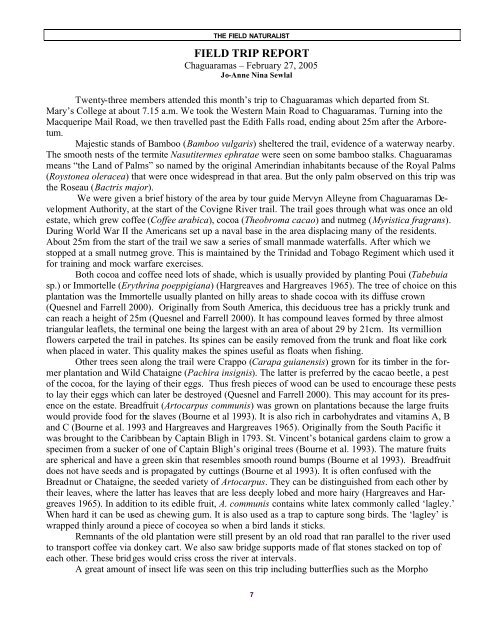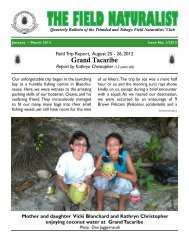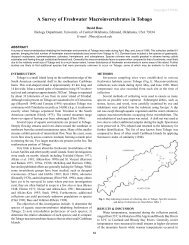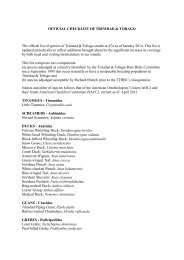Vol 2 - The Trinidad and Tobago Field Naturalists' Club
Vol 2 - The Trinidad and Tobago Field Naturalists' Club
Vol 2 - The Trinidad and Tobago Field Naturalists' Club
Create successful ePaper yourself
Turn your PDF publications into a flip-book with our unique Google optimized e-Paper software.
THE FIELD NATURALISTFIELD TRIP REPORTChaguaramas – February 27, 2005Jo-Anne Nina SewlalTwenty-three members attended this month’s trip to Chaguaramas which departed from St.Mary’s College at about 7.15 a.m. We took the Western Main Road to Chaguaramas. Turning into theMacqueripe Mail Road, we then travelled past the Edith Falls road, ending about 25m after the Arboretum.Majestic st<strong>and</strong>s of Bamboo (Bamboo vulgaris) sheltered the trail, evidence of a waterway nearby.<strong>The</strong> smooth nests of the termite Nasutitermes ephratae were seen on some bamboo stalks. Chaguaramasmeans “the L<strong>and</strong> of Palms” so named by the original Amerindian inhabitants because of the Royal Palms(Roystonea oleracea) that were once widespread in that area. But the only palm observed on this trip wasthe Roseau (Bactris major).We were given a brief history of the area by tour guide Mervyn Alleyne from Chaguaramas DevelopmentAuthority, at the start of the Covigne River trail. <strong>The</strong> trail goes through what was once an oldestate, which grew coffee (Coffee arabica), cocoa (<strong>The</strong>obroma cacao) <strong>and</strong> nutmeg (Myristica fragrans).During World War II the Americans set up a naval base in the area displacing many of the residents.About 25m from the start of the trail we saw a series of small manmade waterfalls. After which westopped at a small nutmeg grove. This is maintained by the <strong>Trinidad</strong> <strong>and</strong> <strong>Tobago</strong> Regiment which used itfor training <strong>and</strong> mock warfare exercises.Both cocoa <strong>and</strong> coffee need lots of shade, which is usually provided by planting Poui (Tabebuiasp.) or Immortelle (Erythrina poeppigiana) (Hargreaves <strong>and</strong> Hargreaves 1965). <strong>The</strong> tree of choice on thisplantation was the Immortelle usually planted on hilly areas to shade cocoa with its diffuse crown(Quesnel <strong>and</strong> Farrell 2000). Originally from South America, this deciduous tree has a prickly trunk <strong>and</strong>can reach a height of 25m (Quesnel <strong>and</strong> Farrell 2000). It has compound leaves formed by three almosttriangular leaflets, the terminal one being the largest with an area of about 29 by 21cm. Its vermillionflowers carpeted the trail in patches. Its spines can be easily removed from the trunk <strong>and</strong> float like corkwhen placed in water. This quality makes the spines useful as floats when fishing.Other trees seen along the trail were Crappo (Carapa guianensis) grown for its timber in the formerplantation <strong>and</strong> Wild Chataigne (Pachira insignis). <strong>The</strong> latter is preferred by the cacao beetle, a pestof the cocoa, for the laying of their eggs. Thus fresh pieces of wood can be used to encourage these peststo lay their eggs which can later be destroyed (Quesnel <strong>and</strong> Farrell 2000). This may account for its presenceon the estate. Breadfruit (Artocarpus communis) was grown on plantations because the large fruitswould provide food for the slaves (Bourne et al 1993). It is also rich in carbohydrates <strong>and</strong> vitamins A, B<strong>and</strong> C (Bourne et al. 1993 <strong>and</strong> Hargreaves <strong>and</strong> Hargreaves 1965). Originally from the South Pacific itwas brought to the Caribbean by Captain Bligh in 1793. St. Vincent’s botanical gardens claim to grow aspecimen from a sucker of one of Captain Bligh’s original trees (Bourne et al. 1993). <strong>The</strong> mature fruitsare spherical <strong>and</strong> have a green skin that resembles smooth round bumps (Bourne et al 1993). Breadfruitdoes not have seeds <strong>and</strong> is propagated by cuttings (Bourne et al 1993). It is often confused with theBreadnut or Chataigne, the seeded variety of Artocarpus. <strong>The</strong>y can be distinguished from each other bytheir leaves, where the latter has leaves that are less deeply lobed <strong>and</strong> more hairy (Hargreaves <strong>and</strong> Hargreaves1965). In addition to its edible fruit, A. communis contains white latex commonly called ‘lagley.’When hard it can be used as chewing gum. It is also used as a trap to capture song birds. <strong>The</strong> ‘lagley’ iswrapped thinly around a piece of cocoyea so when a bird l<strong>and</strong>s it sticks.Remnants of the old plantation were still present by an old road that ran parallel to the river usedto transport coffee via donkey cart. We also saw bridge supports made of flat stones stacked on top ofeach other. <strong>The</strong>se bridges would criss cross the river at intervals.A great amount of insect life was seen on this trip including butterflies such as the Morpho7








